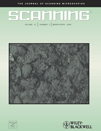Effect of fabrication process parameters on the apex-radius of STM tungsten nanotip
Abstract
Scanning tunneling microscope (STM) has found a wide application in nanoscience and nanotechnology. This microscope uses an ultra-sharp metallic tip for image acquisition. Resolution of STM images depends largely on the radius of the tip apex; the smaller the radius the higher the resolution. In the present research, an experimental set-up was designed and implemented for fabrication of STM tungsten nanotip using electrochemical-etching method with the aim of optimization of nanotip fabrication process parameters by using Taguchi method. These parameters are electrolyte concentration, immersion length of the tungsten wire, inner diameter of the cathode tube, and the process voltage. It was found that the optimum level of the process parameters for gaining minimum radius of the nanotip apex is electrolyte concentration of 2 M/lit, wire immersion length of 4 mm, cathode tube inner diameter of 55 mm, and voltage of 3.5 V within the range of experiments. By setting the process parameters on the optimum level, the radius of the nanotip apex was decreased by five times in comparison to the mean value of the experimental results. The radius of the nanotip apex was improved down to about 10 nm under the optimum conditions. SCANNING 31: 65–74, 2009. © 2009 Wiley Periodicals, Inc.




